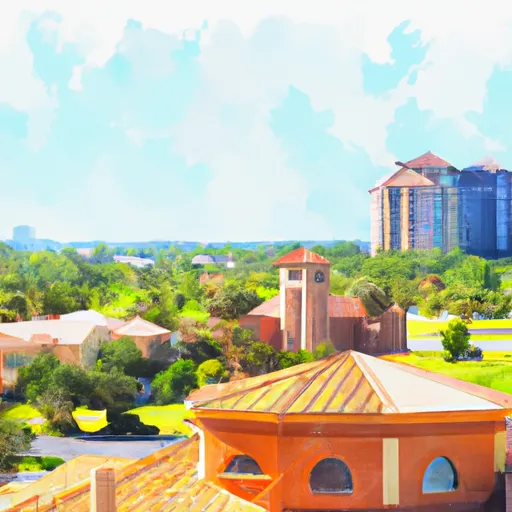-
 Snoflo Premium
Snoflo Premium
Get unlimited access to all our content
With no Ad interruptions! - Start Your Free Trial Login with existing account
Village-Of-Golf
Eden Index
Climate
5.4
•
Recreation
4.2
•
Community
3.2
•
Safeguard
4.4/10

Village of Golf is a small town located in Palm Beach County, Florida. It has a subtropical climate, characterized by hot and humid summers and mild winters. The average annual temperature ranges from 68°F (20°C) in winter to 82°F (28°C) in summer. The area receives abundant rainfall, with an average of 60 inches per year, which is distributed relatively evenly throughout the year.
Situated in South Florida, Village of Golf is surrounded by various bodies of water, including lakes, canals, and the nearby Atlantic Ocean. These hydrology constituents provide opportunities for water-based activities such as fishing, boating, and kayaking. The town's proximity to the coastline also offers beach lovers a chance to enjoy swimming, sunbathing, and beachcombing.
Apart from aquatic activities, Village of Golf is home to several parks and nature preserves, providing residents and visitors with opportunities for outdoor recreation. Residents can explore the lush green spaces, go hiking, biking, have picnics, or simply enjoy the natural beauty of the area. Golf enthusiasts can also take advantage of the town's well-maintained golf courses, which provide a scenic setting for a round of golf.
What is the Eden Index?
The Snoflo Eden Index serves as a comprehensive rating system for regions, evaluating their desirability through a holistic assessment of climate health, outdoor recreation opportunities, and natural disaster risk, acknowledging the profound impact of these factors on livability and well-being.
Climate Health Indicator (CHI): 5.4
Village-Of-Golf receives approximately
1581mm of rain per year,
with humidity levels near 82%
and air temperatures averaging around
24°C.
Village-Of-Golf has a plant hardyness factor of
10, meaning
plants and agriculture in this region tend to thrive here all year round.
By considering the ideal temperature range, reliable water supplies, clean air, and stable seasonal rain or snowpacks, the Climate Health Indicator (CHI) underscores the significance of a healthy climate as the foundation for quality living.
A healthy climate is paramount for ensuring a high quality of life and livability in a region, fostering both physical well-being and environmental harmony. This can be characterized by ideal temperatures, reliable access to water supplies, clean air, and consistent seasonal rain or snowpacks.
Weather Forecast
Streamflow Conditions
Southern Florida
Area Rivers
Southern Florida
Snowpack Depths
Southern Florida
Reservoir Storage Capacity
Southern Florida
Groundwater Levels
Recreational Opportunity Index (ROI): 4.2
The Recreational Opportunity Index (ROI) recognizes the value of outdoor recreational options, such as parks, hiking trails, camping sites, and fishing spots, while acknowledging that climate plays a pivotal role in ensuring the comfort and consistency of these experiences.
Access to outdoor recreational opportunities, encompassing activities such as parks, hiking, camping, and fishing, is crucial for overall well-being, and the climate plays a pivotal role in enabling and enhancing these experiences, ensuring that individuals can engage in nature-based activities comfortably and consistently.
Camping Areas
| Campground | Campsites | Reservations | Toilets | Showers | Elevation |
|---|---|---|---|---|---|
| Jonathan Dickinson State Park | None | 25 ft | |||
| Easterlin Park | None | 3 ft | |||
| Topeekeegee Yugnee County Park | 60 | 5 ft | |||
| Phipps County Park | None | 14 ft | |||
| St. Lucie Lock | None | 20 ft | |||
| Quiet Waters Park | None | 14 ft | |||
| CB Smith Park | None | 6 ft | |||
| Savannas Recreational Park | 56 | 16 ft |
Catastrophe Safeguard Index (CSI):
The Catastrophe Safeguard Index (CSI) recognizes that natural disaster risk, encompassing floods, fires, hurricanes, and tornadoes, can drastically affect safety and the overall appeal of an area.
The level of natural disaster risk in a region significantly affects safety and the overall livability, with climate change amplifying these risks by potentially increasing the frequency and intensity of events like floods, fires, hurricanes, and tornadoes, thereby posing substantial challenges to community resilience and well-being.
Community Resilience Indicator (CRI): 3.2
The Community Resilience Indicator (CRI) recognizes that education, healthcare, and socioeconomics are crucial to the well-being of a region. The CRI acknowledges the profound impact of these elements on residents' overall quality of life. By evaluating educational resources, healthcare accessibility, and economic inclusivity, the index captures the essential aspects that contribute to a thriving community, fostering resident satisfaction, equity, and social cohesion.

